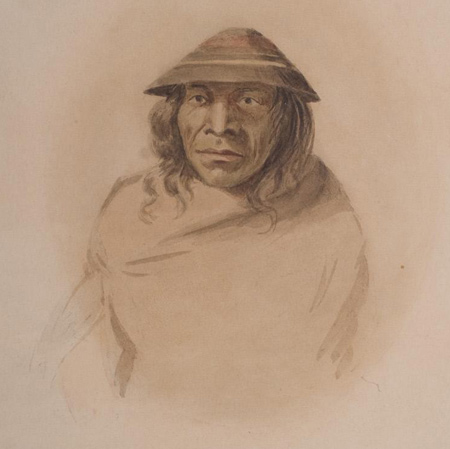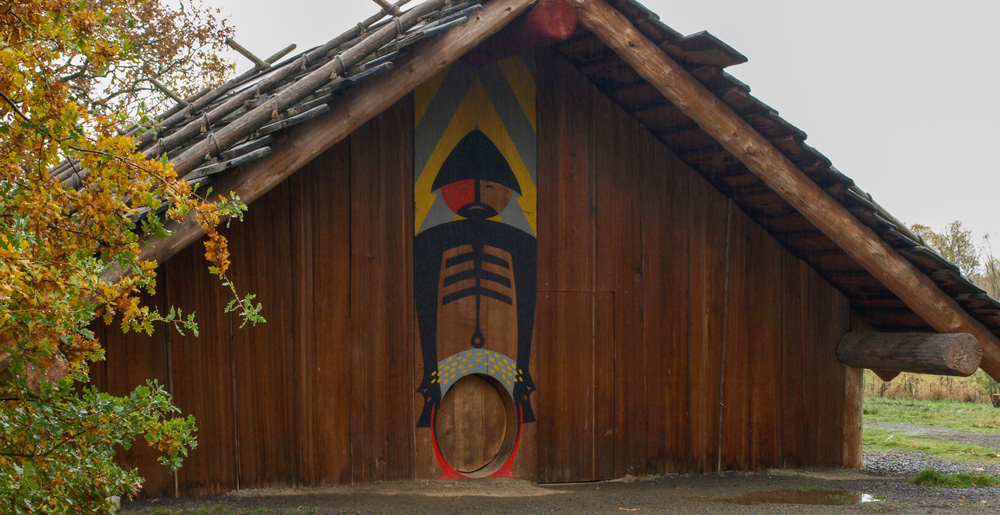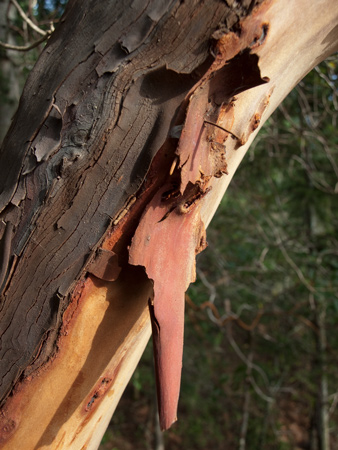North Bonneville, WA The day is cold as most of the men move baggage and canoes around the Cascades of the Columbia. Clark describes Upper Chinookan Watlala Indians living in the area.
Ska-tel-sun (Cowlitz Indian, 1847)
Paul Kane (1810–1871)
Courtesy Stark Museum of Art, http://collections.starkculturalvenues.org, 31.78.104.
Ska-tel-sun was Cowlitz, a Salishan-speaking people whose culture often merged with Chinookans, especially around the mouth of their namesake river.
All Canoes Safely through the Great Chute[1]Originally aired weekdays by Yellowstone Public Radio during the Bicentennial observance of 2003-2006. Narrated by Hal Hansen. Scripts by Whit Hansen and Ed Jacobson. Produced by Leni Holliman. © … Continue reading
Portaging the “Great Shute”
we got all our baggage over the Portage of 940 yards, after which we got the 4 large Canoes over by Slipping them over the rocks on poles placed across from one rock to another, and at Some places along partial Streams of the river. in passing those canoes over the rocks &c. three of them recived injuries which obliged us to delay to have them repared.
—William Clark
Watlala Woven Hats
Those [Watlala] people gave me to eate nuts berries & a little dried fish, and Sold me a hat of ther own taste without a brim, and baskets in which they hold their water—
—William Clark
Great Traders
they appear to trade mostly i e’ Pounded fish, Beargrass, and roots; cannot be an object of comerce with furin merchants— however they git in return for those articles Blue and white beeds copper Tea Kittles, brass arm bands, some Scarlet and blue robes and a fiew articles of old clothes, they prefer beeds to any thing and will part with the last mouthfull or articles of clothing they have for a fiew of those beeds, those beeds the trafick with Indians Still higher up this river for roabs, Skins, cha-pel-el bread, beargrass &c. who in their turn trafick with those under the rockey mountains for Beargrass, Pashico roots & robes &c.
—William Clark
Cathlapotle Plankhouse
© 9 November 2008 by Kristopher K. Townsend. Permission to use granted under the Creative Commons Attribution-Share Alike 4.0 International license.
Large Chinook Lodges
visited the Indian Village found that the Construction of the houses Similar to those abov described, with this difference only that they are larger Say from 35 to 50 feet by 30 feet, raised about 5 feet above the earth, and nearly as much below The Dores in the Same form and Size cut in the wide post which Supports one end of the ridge pole and which is carved and painted with different figures & Hieroglyphics
—William Clark
Upper Chinookan Health
The nativs of the waters of the Columbia appear helthy, Some have tumers on different parts of their bodies, and Sore and weak Eyes are common, maney have lost their Sight entirely great numbers with one eye out and frequently the other verry weak; This misfortune I must again asscribe to the water &c. They have bad teeth, which is not common with indians, maney have worn their teeth down and Some quite into their gums, this I cannot Satisfactorily account for it, do ascribe it in some measure to their method of eateing, their food, roots pertiularly, which they make use of as they are taken out of the earth frequently nearly covered with Sand, I have not Seen any of their long roots offered for Sale clear of Sand.
—William Clark
Pacific Madrone
Arutus menziesii
Little Cape Horn on the lower Columbia River, 19 December 2010. © by Kristopher K. Townsend. Permission to use granted under the Creative Commons Attribution-Share Alike 4.0 International license.
Pacific Madrone Specimen
A middle size tree with a remarkable smooth bark which Scales off in the manner of the birch; & red berries in clusters. Columbia R. Novbr: 1st 1805.
—Meriwether Lewis[2]Arutus menziesii. Moulton, ed. Herbarium, specimen 14.
Sea Otters
Great numbers of Sea Otters, they are So cautious that I with dificuelty got a Shot at one to day, which I must have killed, but could not get him as he Sunk
—William Clark
Weather Diary
Day of the month Wind State of the Weather 1st N. E fair —Meriwether Lewis[3]Some abbreviations have been spelled out.
Beacon Rock is a High Potential Historic Site along the Lewis and Clark National Historic Trail managed by the U.S. National Park Service. The site is managed by Washington State Parks.
Notes
| ↑1 | Originally aired weekdays by Yellowstone Public Radio during the Bicentennial observance of 2003-2006. Narrated by Hal Hansen. Scripts by Whit Hansen and Ed Jacobson. Produced by Leni Holliman. © 2003 by Yellowstone Public Radio. |
|---|---|
| ↑2 | Arutus menziesii. Moulton, ed. Herbarium, specimen 14. |
| ↑3 | Some abbreviations have been spelled out. |





